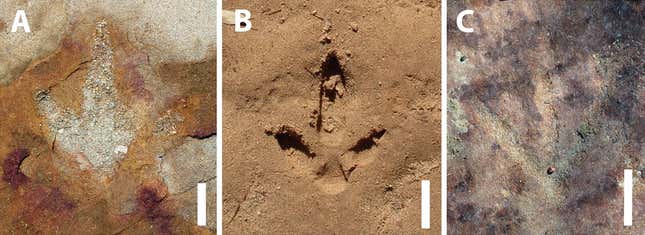Ancient South Americans were apparently inspired by fossilized dinosaur tracks in what is now eastern Brazil, where they cut figures into the rock, imprinted tens of millions of years earlier by the movements of giants.
The dinosaur tracks belong to theropods, sauropods, and iguanodontians, and are spread across three rock outcroppings in the Brazilian state of Paraíba. The petroglyphs on the site consist primarily of circular patterns, but several look very much like the tridactyl dinosaur tracks also present on the site. The team’s research cataloguing the petroglyphs and associated trackways was published in Scientific Reports.
Neither the trackways nor the petroglyphs have been directly dated, but human burials dating to 10,000 years ago were previously found at two nearby sites. One of those sites, Pedra do Alexandre, has burials spanning from 9,400 years old to 2,620 years old, indicating there’s still a wide time frame in which the petroglyphs could have been carved. But the petroglyphs placement, and the design of some of the figures, was clearly inspired by the much more ancient trackways.
Theropods were a group of bipedal, often carnivorous creatures that includes T. rex and all modern birds. Sauropods were massive, herbivorous quadrupeds easily recognizable for their long necks, if not their huge bodies. Iguanodontians were a bipedal, herbivorous group that included the thumb-spiked, eponymous Iguanodon, as well as the duck-billed hadrosaurs.

Brazil was once a hotbed for a bevy of ancient beasts, including dinosaurs, their winged counterparts (pterosaurs), and other, more ancient reptiles. In fact, fossil smuggling out of Brazil remains a vexing problem for authorities.
The proximity of the petroglyphs to the fossilized footprints reveals “active engagement with the fossil material,” the team wrote, “suggesting that these traces not only caught the attention of the native community but were meaningful and became integrated into their knowledge repertoire.”
No petroglyphs overlapped with or caused damage to the footprints on the site—“suggesting thoughtfulness by the makers,” they wrote. Absolute dating of the petroglyphs using X-ray fluorescence spectroscopy could reveal when they were made—perhaps across the centuries, by different groups.
The team cites petroglyphs at the nearby Junco archaeological site, which depict an assortment of geometric figures that resemble stars, spoked wheels, flowers, and (if you squint) buildings. The petroglyphs were authored by multiple people, the team concluded, based on variation in style across the figures. Some of the figures and trackways are severely damaged due to flaking of the rock.

Given ancient South Americans’ lack of modern understanding of dinosaurs, the team added that the petroglyph makers may have mistaken the dinosaur trackways for rhea footprints. Rheas are modern theropod dinosaurs and the largest bird in Brazil—indeed, native to the same region where the paleontological site sits.
That may be so, but unlike the genuine rhea tracks those ancient communities saw, the ones in the rock in Paraíba didn’t go away. That gave the prints some significance to the local community, as evidenced by the ancient artwork placed alongside them.




















+ There are no comments
Add yours